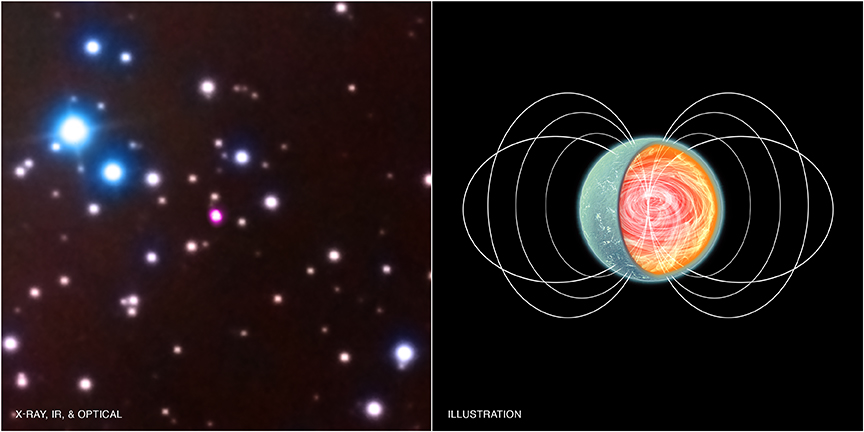NASA | Marshall | SAO | Chandra X-ray Observatory | 2013 May 23
This graphic shows an exotic object in our galaxy called SGR 0418+5729 (SGR 0418 for short). As described in our press release, SGR 0418 is a magnetar, a type of neutron star that has a relatively slow spin rate and generates occasional large blasts of X-rays.
The only plausible source for the energy emitted in these outbursts is the magnetic energy stored in the star. Most magnetars have extremely high magnetic fields on their surface that are ten to a thousand times stronger than for the average neutron star. New data shows that SGR 0418 doesn't fit that pattern. It has a surface magnetic field similar to that of mainstream neutron stars.
In the image on the left, data from NASA's Chandra X-ray Observatory shows SGR 0418 as a pink source in the middle (mouse over the image above). Optical data from the William Herschel telescope in La Palma and infrared data from NASA's Spitzer Space Telescope are shown in red, green and blue.
On the right is an artist's impression showing a close-up view of SGR 0418. This illustration highlights the weak surface magnetic field of the magnetar, and the relatively strong, wound-up magnetic field lurking in the hotter interior of the star. The X-ray emission seen with Chandra comes from a small hot spot, not shown in the illustration. At the end of the outburst this spot has a radius of only about 160 meters, compared with a radius for the whole star of about 12 km.
The researchers monitored SGR 0418 for over three years using Chandra, ESA's XMM-Newton as well as NASA's Swift and RXTE satellites. They were able to make an accurate estimate of the strength of the external magnetic field by measuring how its rotation speed changes during an X-ray outburst. These outbursts are likely caused by fractures in the crust of the neutron star precipitated by the buildup of stress in the stronger magnetic field lying below the surface.
By modeling the evolution of the cooling of the neutron star and its crust, as well as the gradual decay of its magnetic field, the researchers estimated that SGR 0418 is about 550,000 years old. This makes SGR 0418 older than most other magnetars, and this extended lifetime has probably allowed the surface magnetic field strength to decline over time. Because the crust weakened and the interior magnetic field is relatively strong, outbursts could still occur.
The implications of this result for understanding supernova explosions and the number and evolution of magnetars is discussed in the press release.
SGR 0418 is located in the Milky Way galaxy at a distance of about 6,500 light years from Earth.
Image Credits: Illustration: NASA/CXC/M.Weiss; X-ray: NASA/CXC/CSIC-IEEC/N.Rea et al;
Optical: Isaac Newton Group of Telescopes, La Palma/WHT; Infrared: NASA/JPL-Caltech
The Outburst Decay of the Low Magnetic Field Magnetar SGR 0418+5729 - N. Rea et al
- Astrophysical Journal 770(1) 65 (2013 June 10) DOI: 10.1088/0004-637X/770/1/65
arXiv.org > astro-ph > arXiv:1303.5579 > 22 Mar 2013 (v1), 17 Apr 2013 (v2)
Crouching Tiger Hidden Magnetar
Discovery News | Markus Hammonds | 2013 May 29
